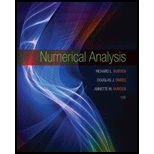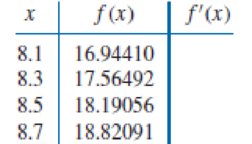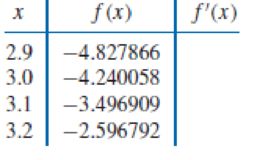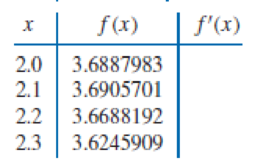
Numerical Analysis
10th Edition
ISBN: 9781305253667
Author: Richard L. Burden, J. Douglas Faires, Annette M. Burden
Publisher: Cengage Learning
expand_more
expand_more
format_list_bulleted
Concept explainers
Textbook Question
Chapter 4.1, Problem 7ES
The data in Exercise 5 were taken from the following functions. Compute the actual errors in Exercise 5 and find error bounds using the error formulas.
- a. f (x) = e2x
- b. f (x) = x ln x
- c. f (x) = x cos x − x2 sin x
- d. f (x) = 2(ln x)2 + 3 sin x
5. Use the most accurate three-point formula to determine each missing entry in the following tables.




Expert Solution & Answer
Want to see the full answer?
Check out a sample textbook solution
Students have asked these similar questions
Suppose an experiment was conducted to compare the mileage(km) per litre
obtained by competing brands of petrol I,II,III. Three new Mazda, three new
Toyota and three new Nissan cars were available for experimentation. During the
experiment the cars would operate under same conditions in order to eliminate
the effect of external variables on the distance travelled per litre on the assigned
brand of petrol. The data is given as below:
Brands of Petrol Mazda Toyota Nissan
I 10.6 12.0 11.0
II 9.0 15.0 12.0
III 12.0 17.4 13.0
(a) Test at the 5% level of significance whether there are signi
cant differences among the brands of fuels and also among the cars. [10]
(b) Compute the standard error for comparing any two fuel brands means. Hence
compare, at the 5% level of significance, each of fuel brands II, and III with
the standard fuel brand I. [10] �
Business discuss
Use the method of undetermined coefficients to solve the given nonhomogeneous system.X' =
−1 33 −1
X +
−4t2t + 2
X(t) =
Chapter 4 Solutions
Numerical Analysis
Ch. 4.1 - Use the forward-difference formulas and...Ch. 4.1 - The data in Exercise 1 were taken from the...Ch. 4.1 - Use the most accurate three-point formula to...Ch. 4.1 - Use the most accurate three-point formula to...Ch. 4.1 - The data in Exercise 5 were taken from the...Ch. 4.1 - The data in Exercise 6 were taken from the...Ch. 4.1 - Prob. 9ESCh. 4.1 - Use the formulas given in this section to...Ch. 4.1 - The data in Exercise 9 were taken from the...Ch. 4.1 - Prob. 12ES
Ch. 4.1 - Use the following data and the knowledge that the...Ch. 4.1 - Prob. 14ESCh. 4.1 - Prob. 15ESCh. 4.1 - Prob. 16ESCh. 4.1 - Prob. 17ESCh. 4.1 - Prob. 18ESCh. 4.1 - Prob. 19ESCh. 4.1 - Prob. 20ESCh. 4.1 - Prob. 21ESCh. 4.1 - In a circuit with impressed voltage (t) and...Ch. 4.1 - In Exercise 9 of Section 3.4, data were given...Ch. 4.1 - Derive an O(h4) five-point formula to approximate...Ch. 4.1 - Use the formula derived in Exercise 24 and the...Ch. 4.1 - a. Analyze the round-off errors, as in Example 4,...Ch. 4.1 - Derive a method for approximating f (x0) whose...Ch. 4.1 - Consider the function e(h)=h+h26M, where M is a...Ch. 4.1 - Prob. 1DQCh. 4.1 - Prob. 2DQCh. 4.2 - Apply the extrapolation process described in...Ch. 4.2 - Add another line to the extrapolation table in...Ch. 4.2 - The following data give approximations to the...Ch. 4.2 - Prob. 6ESCh. 4.2 - Prob. 7ESCh. 4.2 - The forward-difference formula can be expressed as...Ch. 4.2 - Prob. 9ESCh. 4.2 - Prob. 10ESCh. 4.2 - Prob. 11ESCh. 4.2 - Prob. 12ESCh. 4.2 - Prob. 13ESCh. 4.3 - Approximate the following integrals using the...Ch. 4.3 - Approximate the following integrals using the...Ch. 4.3 - Find a bound for the error in Exercise 1 using the...Ch. 4.3 - Prob. 4ESCh. 4.3 - Repeat Exercise 1 using Simpsons rule. 1....Ch. 4.3 - Prob. 6ESCh. 4.3 - Prob. 7ESCh. 4.3 - Prob. 8ESCh. 4.3 - Prob. 9ESCh. 4.3 - Prob. 10ESCh. 4.3 - Prob. 11ESCh. 4.3 - Prob. 12ESCh. 4.3 - The Trapezoidal rule applied to 02f(x)dx gives the...Ch. 4.3 - Prob. 14ESCh. 4.3 - Approximate the following integrals using formulas...Ch. 4.3 - Prob. 17ESCh. 4.3 - Suppose that the data of Exercise 17 have...Ch. 4.3 - Prob. 19ESCh. 4.3 - Prob. 20ESCh. 4.3 - The quadrature formula...Ch. 4.3 - The quadrature formula...Ch. 4.3 - Find the constants c0, c1, and x1 so that the...Ch. 4.3 - Find the constants x0, x1, and c1 so that the...Ch. 4.3 - Prob. 25ESCh. 4.3 - Prob. 26ESCh. 4.3 - Prob. 27ESCh. 4.3 - Derive Simpsons Three-Eighths rule (the closed...Ch. 4.3 - Prob. 1DQCh. 4.3 - Prob. 2DQCh. 4.4 - Use the Composite Trapezoidal rule with the...Ch. 4.4 - Prob. 2ESCh. 4.4 - Use the Composite Simpsons rule to approximate the...Ch. 4.4 - Prob. 4ESCh. 4.4 - Prob. 5ESCh. 4.4 - Prob. 6ESCh. 4.4 - Prob. 7ESCh. 4.4 - Prob. 8ESCh. 4.4 - Prob. 9ESCh. 4.4 - Prob. 10ESCh. 4.4 - Determine the values of n and h required to...Ch. 4.4 - Repeat Exercise 11 for the integral 0x2cosxdx. 11....Ch. 4.4 - Determine the values of n and h required to...Ch. 4.4 - Repeat Exercise 13 for the integral 12xlnxdx. 13....Ch. 4.4 - Prob. 15ESCh. 4.4 - Prob. 17ESCh. 4.4 - A car laps a race track in 84 seconds. The speed...Ch. 4.4 - Prob. 19ESCh. 4.4 - Prob. 20ESCh. 4.4 - Prob. 21ESCh. 4.4 - Prob. 23ESCh. 4.4 - Prob. 24ESCh. 4.4 - Prob. 25ESCh. 4.4 - Prob. 26ESCh. 4.4 - Prob. 1DQCh. 4.4 - Prob. 2DQCh. 4.5 - Use Romberg integration to compute R3, 3 for the...Ch. 4.5 - Use Romberg integration to compute R3, 3 for the...Ch. 4.5 - Prob. 3ESCh. 4.5 - Prob. 4ESCh. 4.5 - Use the following data to approximate 15f(x)dx as...Ch. 4.5 - Prob. 9ESCh. 4.5 - Prob. 10ESCh. 4.5 - Prob. 11ESCh. 4.5 - Romberg integration for approximating 01f(x)dx...Ch. 4.5 - Prob. 15ESCh. 4.5 - Prob. 18ESCh. 4.5 - Prob. 19ESCh. 4.5 - Prob. 1DQCh. 4.5 - Prob. 4DQCh. 4.6 - Prob. 1ESCh. 4.6 - Prob. 2ESCh. 4.6 - Prob. 11ESCh. 4.6 - Prob. 12ESCh. 4.6 - Could Romberg integration replace Simpsons rule in...Ch. 4.7 - Approximate the following integrals using Gaussian...Ch. 4.7 - Approximate the following integrals using Gaussian...Ch. 4.7 - Repeat Exercise 1 with n = 3. 1. Approximate the...Ch. 4.7 - Repeat Exercise 2 with n = 3. 2. Approximate the...Ch. 4.7 - Repeat Exercise 1 with n = 4. 1. Approximate the...Ch. 4.7 - Repeat Exercise 2 with n = 4. 2. Approximate the...Ch. 4.7 - Repeat Exercise 1 with n = 5. 1. Approximate the...Ch. 4.7 - Repeat Exercise 2 with n = 5. 2. Approximate the...Ch. 4.7 - Describe the differences and similarities between...Ch. 4.7 - Prob. 2DQCh. 4.8 - Prob. 1DQCh. 4.8 - Prob. 2DQCh. 4.8 - Prob. 3DQCh. 4.8 - Prob. 4DQCh. 4.9 - Suppose a body of mass m is traveling vertically...Ch. 4.9 - The Laguerre polynomials {L0(x), L1(x) ...} form...Ch. 4.9 - Prob. 7ESCh. 4.9 - Prob. 8ESCh. 4.9 - Prob. 9ESCh. 4.9 - Prob. 1DQCh. 4.9 - Prob. 2DQ
Additional Math Textbook Solutions
Find more solutions based on key concepts
Testing Hypotheses. In Exercises 13-24, assume that a simple random sample has been selected and test the given...
Elementary Statistics Using The Ti-83/84 Plus Calculator, Books A La Carte Edition (5th Edition)
The largest polynomial that divides evenly into a list of polynomials is called the _______.
Elementary & Intermediate Algebra
Find all solutions of each equation in the interval .
Precalculus: A Unit Circle Approach (3rd Edition)
Silvia wants to mix a 40% apple juice drink with pure apple juice to make 2 L of a juice drink that is 80% appl...
Beginning and Intermediate Algebra
For Problems 23-28, write in simpler form, as in Example 4. logbFG
Finite Mathematics for Business, Economics, Life Sciences and Social Sciences
Knowledge Booster
Learn more about
Need a deep-dive on the concept behind this application? Look no further. Learn more about this topic, subject and related others by exploring similar questions and additional content below.Similar questions
- 5) You are purchasing a game for $30. You have a 5% off coupon and sales tax is 5%. What will your final price be? Does it matter if you take off the coupon first or add in the tax first? 6) You have ten coupons that allow you to take 10% off the sales price of a jacket, and for some strange reason, the store is going to allow you to use all ten coupons! Does this mean you get the jacket for free? Let's really think about what would happen at the checkout. First, the teller would scan the price tag on the jacket, and the computer would show the price is $100. After the teller scans the first coupon, the computer will take 10% off of $100, and show the price is $90. (Right? Think about why this is.) Then after the teller scans the second coupon, the computer will take 10% off of $90. (a) Continue this reasoning to fill in the table below showing the price of the jacket (y) after you apply x coupons. (b) Make a graph showing the price of the jacket from x = 0 to x = 10 coupons applied.…arrow_forwardDetailed report without CHATGPT, accept if you can give with code and plots, previous reported . Do not waste my question.arrow_forwardPlease do not give inappropriate solutions, previous question reported, i need correct report solution for this, NO CHATGPTarrow_forward
- Need detailed report without CHATGPT, accept if you can give with code and plots, previous reported Plots are required.arrow_forwardNeed detailed report without CHATGPT, accept if you can give with code and plots, previous reportedarrow_forwardWhat would you say about a set of quantitative bivariate data whose linear correlation is -1? What would a scatter diagram of the data look like? (5 points)arrow_forward
- 1. Which set of parametric equations is shown in the graph below? Explain your reasoning. a) x = t; y = t² b) x = = t²; y = t -3-2-1 5 4 3 2 1 12 3 2. Using the graph of f, a. determine whether dy/dt is positive or negative given that dx/dt is negative and b. determine whether dx/dt is positive or negative given that dy/dt is positive. Explain your reasoning. 2 f x 1 2 3 4arrow_forwardFind the perimeter of the triangle. Express the perimeter using the same unit of measure that appears on the given sides. 9 ft 13 ft 6 ft The perimeter isarrow_forwardUse the formula for Pr to evaluate the following expression. 9P5 9P5 =☐arrow_forward
- Find the volume of the figure. The volume of the figure is 3 m 3 m 3 marrow_forwardFind the circumference and area of the circle. Express answers in terms of and then round to the nearest tenth. Find the circumference in terms of C= (Type an exact answer in terms of x.) Find the circumference rounded to the nearest tenth. C= Find the area in terms of A= (Type an exact answer in terms of x.) Find the area rounded to the nearest tenth. A= 10 cmarrow_forwardSox & Sin (px) dx 0arrow_forward
arrow_back_ios
SEE MORE QUESTIONS
arrow_forward_ios
Recommended textbooks for you
- Algebra & Trigonometry with Analytic GeometryAlgebraISBN:9781133382119Author:SwokowskiPublisher:Cengage


 Trigonometry (MindTap Course List)TrigonometryISBN:9781337278461Author:Ron LarsonPublisher:Cengage Learning
Trigonometry (MindTap Course List)TrigonometryISBN:9781337278461Author:Ron LarsonPublisher:Cengage Learning

Algebra & Trigonometry with Analytic Geometry
Algebra
ISBN:9781133382119
Author:Swokowski
Publisher:Cengage



Trigonometry (MindTap Course List)
Trigonometry
ISBN:9781337278461
Author:Ron Larson
Publisher:Cengage Learning
Finding the length of an arc; Author: Maths Genie;https://www.youtube.com/watch?v=fWGPf5peCc8;License: Standard YouTube License, CC-BY
Circles, Angle Measures, Arcs, Central & Inscribed Angles, Tangents, Secants & Chords - Geometry; Author: The Organic Chemistry Tutor;https://www.youtube.com/watch?v=nd46bA9DKE0;License: Standard Youtube License